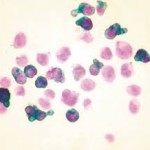 Taxanes are mainly used in the treatment of breast, ovarian, and lung cancers. Paclitaxel and docetaxel are known to cause pneumonitis with estimated frequencies of 0.73 to 12% and 7 to 26%, respectively. Dyspnea, cough, hypoxemia, and pulmonary infiltrates usually develop 1 week to 3 months after treatment. Possible risk factors for pulmonary toxicity are weekly or biweekly therapy compared to triweekly therapy and concurrent treatment with gemcitabine and irinotecan. Severe pneumonitis and pulmonary fibrosis resulting in death have been described. Mild cases of pneumonitis tend to resolve spontaneously or after low-dose prednisone therapy (ie, prednisone, 40 mg daily for 2 weeks). Mild pneumonitis is not a contraindication to subsequent paclitaxel therapies, and the safe readministration of paclitaxel has been reported. Chest imaging findings include bilateral reticular or reticu-lonodular opacities, focal consolidation, and bilateral patchy areas of increased attenuation with upper lobe predominance. A hypersensitivity mechanism has been suggested in the pathogenesis on lung injury. Infusion-related reactions and hypersensitivity reactions may cause bronchos-pasm and hypotension.
Taxanes are mainly used in the treatment of breast, ovarian, and lung cancers. Paclitaxel and docetaxel are known to cause pneumonitis with estimated frequencies of 0.73 to 12% and 7 to 26%, respectively. Dyspnea, cough, hypoxemia, and pulmonary infiltrates usually develop 1 week to 3 months after treatment. Possible risk factors for pulmonary toxicity are weekly or biweekly therapy compared to triweekly therapy and concurrent treatment with gemcitabine and irinotecan. Severe pneumonitis and pulmonary fibrosis resulting in death have been described. Mild cases of pneumonitis tend to resolve spontaneously or after low-dose prednisone therapy (ie, prednisone, 40 mg daily for 2 weeks). Mild pneumonitis is not a contraindication to subsequent paclitaxel therapies, and the safe readministration of paclitaxel has been reported. Chest imaging findings include bilateral reticular or reticu-lonodular opacities, focal consolidation, and bilateral patchy areas of increased attenuation with upper lobe predominance. A hypersensitivity mechanism has been suggested in the pathogenesis on lung injury. Infusion-related reactions and hypersensitivity reactions may cause bronchos-pasm and hypotension.
Topoisomerase I Inhibitors
Irinotecan
Irinotecan is a topoisomerase I inhibitor that is used mainly in the treatment of colon cancer, particularly in combination with other chemotherapy agents. Pneumonitis is a dose-dependent side effect of irinotecan. Moderate-to-severe pneumonitis has been reported in 2 to 16% of patients treated with irinotecan. Severe hypoxemia and respiratory failure requiring mechanical ventilation may develop in about 9% of the patients. Fatalities due to severe pneumonitis have been reported in 1 to 3.5% of patients.
Topotecan
Topotecan is a topoisomerase I inhibitor that is mainly used in the treatment of metastatic carcinoma of the ovary or small cell lung cancer. Dyspnea has been reported in 3 to 4% of patients treated for ovarian or lung cancer. Few cases of topotecan-induced lung toxicity have been described, and include diffuse alveolar damage, organizing pneumonia, mild interstitial fibrosis with numerous intraal-veolar macrophages, and respiratory failure in the setting of preexisting pulmonary fibrosis.
Watch videos about lung cancer
Exatecan
Exatecan is a new and experimental topoisomerase I inhibitor that has activity against a number of solid tumors. Although in one phase II study mild to moderate dyspnea developed in 36% of patients treated with exatecan, pulmonary toxicity secondary to exatecan therapy has not been reported.
Thalidomide
Thalidomide was approved in 2006 for the treatment of multiple myeloma. Thalidomide is also being investigated for treatment of several other cancers. Dyspnea in association with thalidomide therapy has been reported in 4 to 54% of patients. Opportunistic infections including Pneumocystis carinii pneumonia, disseminated herpes zoster, and herpes simplex infections have been described in leukopenic patients receiving thalid-omide. Several studies> have found increased incidence of DVT and pulmonary embolism in association with thalidomide therapy. Thromboembolic disease usually occurs at a mean time of 2 months after thalidomide administration. The reported rates of DVT and pulmonary embolism vary from 0 to 43% of treated patients. Higher rates have been observed among patients who received thalidomide in combination with chemotherapy (16%) or dexametha-sone (15%) compared to thalidomide alone (5%). Thalidomide-induced pneumonitis is extremely rare. Mild interstitial fibrosis, lymphocytic alveolitis, and organizing pneumonia have been described.
Read other posts about Novel Antineoplastic Agents for Solid Tutor:


















